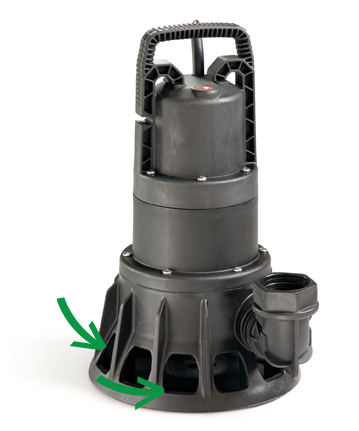Mechanical Filtration 101 Chapter 1
The Simplest Pre-Filters, Pump Screens
Let’s begin our foray into Mechanical Filtration with the Prefilters, which we will define as those filters that remove debris before it can enter the pump. There are as many types of prefilters as there are types of pumps, because keeping unwanted debris from entering a running pump is critical for that pump’s performance and longevity. The simplest type is, of course, the screen that’s built right onto the pump, which only allows debris of a certain size to pass. These are considered “mechanical”, rather than chemical or biological, because they perform the mechanical task of physically blocking solids. Most pumps have a built-in screen prefilter that is removable for cleaning, although they sometimes go unnoticed – a solids-handling pump designed to pass up to 1½” chunks of junk has such large openings in its “screen” it’s hard to recognize it as such. These pumps are able to pass said chunks (and the occasional frog or goldfish – say “Sushi”!) because there’s plenty of clearance inside the volute and between the vanes, but that also means that water can bypass those same vanes. Said another way, the ability to pass solids requires a relatively inefficient pumping design that means that solids-handling pumps will require relatively high wattages for the flow they provide.
In the interests of efficiency and lower operating cost, most pumps designed for residential water features have tighter tolerances and prefer not to ingest such large debris. So-called “clean water pumps” are designed with ¼” or smaller openings in easily-removed prefilters, to allow for the much more frequent cleanings they will require if the screen on the pump is the only prefilter.


Let’s begin our foray into Mechanical Filtration with the Prefilters, which we will define as those filters that remove debris before it can enter the pump. There are as many types of prefilters as there are types of pumps, because keeping unwanted debris from entering a running pump is critical for that pump’s performance and longevity. The simplest type is, of course, the screen that’s built right onto the pump, which only allows debris of a certain size to pass. These are considered “mechanical”, rather than chemical or biological, because they perform the mechanical task of physically blocking solids. Most pumps have a built-in screen prefilter that is removable for cleaning, although they sometimes go unnoticed – a solids-handling pump designed to pass up to 1½” chunks of junk has such large openings in its “screen” it’s hard to recognize it as such. These pumps are able to pass said chunks (and the occasional frog or goldfish – say “Sushi”!) because there’s plenty of clearance inside the volute and between the vanes, but that also means that water can bypass those same vanes. Said another way, the ability to pass solids requires a relatively inefficient pumping design that means that solids-handling pumps will require relatively high wattages for the flow they provide.
In the interests of efficiency and lower operating cost, most pumps designed for residential water features have tighter tolerances and prefer not to ingest such large debris. So-called “clean water pumps” are designed with ¼” or smaller openings in easily-removed prefilters, to allow for the much more frequent cleanings they will require if the screen on the pump is the only prefilter.





